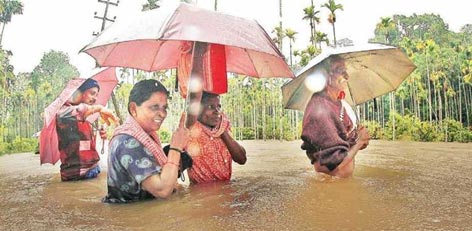No. of views : (5833)
The 3 main attributes which caused the heavy rain in Kerala
Posted on: 18/Aug/2018 4:29:53 PM

The state of Kerala has been suffering from a deluge of rains and floods unprecedented since 1924. The experts have come forward with three major reasons for this.
Madden-Julian Oscillation - Generally, the southwest monsoon rainy season commences in Kerala on 1st June. However, this year, it started much earlier – before the end of May. Further, the transformations in the heat zones in the atmosphere also increased the quantum of rain. This transformation is known as ‘Madden-Julian Oscillation’ This phenomenon causes the rain clouds to drift towards the eastern direction and leads to heavy rain in the equator region. A low-pressure zone was formed last week in the Odisha coastal area. This absorbed all the humidity prevailing in the state. This caused the southwest monsoon seasonal winds to blow strongly towards the eastern direction. This easterly blowing wind was blocked by the Western Ghats in Kerala leading to a formation of a large number of rain-clouds which has caused the persistent heavy rain in Kerala.
Absence of El Nino effect - Due to the ‘global warming’ phenomenon, the water in the oceans tends to be hot. This will lead to the formation of a low-pressure zone. Generally, it takes around 2 weeks for this low-pressure zone to form. However, during this current southwest monsoon season, this has happened quite frequently leading the deluge of rains in Kerala.
Solar Minimum effect - The transformation that occurs in the solar rotation system which occurs once in 11years is known as ‘solar minimum’. During this period, the intensity of the heat in the sunrays get reduced and instead there will be more cosmic rays. This phenomenon of solar minimum is the reason why the southwest monsoon rainy season started earlier before the end of May in Kerala leading to more heavy lightning and thunder.
Generally, the phenomenon known as ‘El Nino’, which causes the Pacific Ocean waters to heat up, affects the monsoon season in the Indian subcontinent. However, there was no El Nino effect during this year’s southwest monsoon season. Instead, the thermal convection effect formed on the seas in the Indonesian areas drifted towards the Indian Ocean. This is another main reason for the excess rains in Kerala. It is worth noting that the last time there were similar excess rains in the year of 1924 was affected by the ‘solar minimum’ effect.
Post your requirement - We will connect with the right vendor or service provider








